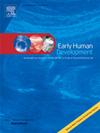Fetal heart rate variability in relation to maternal physical activity and metabolic health
IF 2
3区 医学
Q2 OBSTETRICS & GYNECOLOGY
引用次数: 0
Abstract
Physical activity (PA) during pregnancy may have a positive effect on the fetal cardiac maturation which is reflected in a decreasing resting heart rate and increasing heart rate variability (HRV). Different types of PA, for example during leisure or work time, have differential effects on HRV; however, this relationship has not yet been investigated in pregnancy. In our work, we related different types of PA during pregnancy with maternal and fetal HRV. We assessed the levels of PA in 95 pregnant women between 28 and 32 weeks of gestational age using the Baecke Physical Activity Questionnaire. Maternal and fetal heart rate and HRV were extracted from magnetocardiography recordings at rest, and maternal anthropometric and metabolic parameters were measured, such as fasting glucose and insulin levels, body mass index, and blood pressure. Pearson correlations were calculated between HRV, PA, and maternal parameters. Principal component analysis and generalized linear models were implemented to further investigate these relationships. Our findings indicate that habitual physical activity, whether during leisure or work, has no significant effect on maternal or fetal HRV at rest. However, leisure-time physical activity, unlike work-related activity, is associated with improved maternal insulin sensitivity. Additionally, our exploratory analyses revealed that lower HRV in both the mother and the fetus is associated with poorer maternal metabolic health quantified through higher fasting insulin levels, triglycerides, and adiposity. Finally, male fetuses showed higher HRV compared to females, highlighting the difference in cardiac development between the two biological sexes.
胎儿心率变异性与母体身体活动和代谢健康的关系
妊娠期体力活动(PA)可能对胎儿心脏成熟有积极影响,这反映在静息心率降低和心率变异性(HRV)增加上。不同类型的PA,例如在休闲或工作时间,对HRV有不同的影响;然而,这种关系尚未在怀孕期间进行研究。在我们的工作中,我们将妊娠期间不同类型的PA与母胎HRV联系起来。我们使用Baecke身体活动问卷评估了95名孕龄在28至32周的孕妇的PA水平。从静息时的心脏磁图记录中提取母胎心率和HRV,并测量母体的人体测量和代谢参数,如空腹血糖和胰岛素水平、体重指数和血压。计算HRV、PA和母体参数之间的Pearson相关性。采用主成分分析和广义线性模型进一步研究这些关系。我们的研究结果表明,无论是在休闲还是在工作中,习惯性的体育活动对静止时的母亲或胎儿HRV没有显著影响。然而,与工作相关的活动不同,闲暇时间的体育活动与改善母亲的胰岛素敏感性有关。此外,我们的探索性分析显示,母亲和胎儿较低的HRV与母亲较差的代谢健康有关,通过较高的空腹胰岛素水平、甘油三酯和肥胖来量化。最后,男性胎儿比女性胎儿表现出更高的HRV,突出了两种生理性别在心脏发育方面的差异。
本文章由计算机程序翻译,如有差异,请以英文原文为准。
求助全文
约1分钟内获得全文
求助全文
来源期刊

Early human development
医学-妇产科学
CiteScore
4.40
自引率
4.00%
发文量
100
审稿时长
46 days
期刊介绍:
Established as an authoritative, highly cited voice on early human development, Early Human Development provides a unique opportunity for researchers and clinicians to bridge the communication gap between disciplines. Creating a forum for the productive exchange of ideas concerning early human growth and development, the journal publishes original research and clinical papers with particular emphasis on the continuum between fetal life and the perinatal period; aspects of postnatal growth influenced by early events; and the safeguarding of the quality of human survival.
The first comprehensive and interdisciplinary journal in this area of growing importance, Early Human Development offers pertinent contributions to the following subject areas:
Fetology; perinatology; pediatrics; growth and development; obstetrics; reproduction and fertility; epidemiology; behavioural sciences; nutrition and metabolism; teratology; neurology; brain biology; developmental psychology and screening.
 求助内容:
求助内容: 应助结果提醒方式:
应助结果提醒方式:


